Space
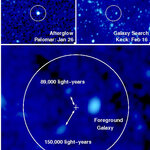
A cosmic explosion that seems to have occurred thousands of light-years from the nearest galaxy-sized collection of stars, gas, and dust has puzzled astronomers. This "shot in the dark" is surprising because the type of explosion, a long-duration gamma-ray burst (GRB), is thought to be powered by the death of a massive star.
"Here we have this very bright burst, yet it's surrounded by darkness on all sides," says Brad Cenko of the California Institute of Technology, Pasadena, Calif., lead author of the team’s paper, which has been accepted for publication in The Astrophysical Journal. "The…
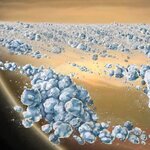
New observations by NASA's Cassini spacecraft indicate the rings of Saturn, once thought to have formed during the age of the dinosaurs, instead may have been created roughly 4.5 billion years ago when the solar system was still under construction.
Professor Larry Esposito, principal investigator for Cassini's Ultraviolet Imaging Spectrograph at CU-Boulder, said data from NASA's Voyager spacecraft in the 1970s and later NASA's Hubble Space Telescope had led scientists to believe Saturn's rings were relatively youthful and likely created by a comet that shattered a large moon, perhaps 100…
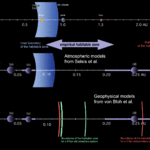
More than 10 years after the discovery of the first extrasolar planet, astronomers have now discovered more than 250 of these planets. Until a few years ago, most of the newly discovered exoplanets were Jupiter-mass, probably gaseous, planets. Recently, astronomers have announced the discovery of several planets that are potentially much smaller, with a minimum mass lower than 10 Earth masses: the now so-called super-Earths [1].
In April, a European team announced in Astronomy & Astrophysics the discovery of two new planets orbiting the M star Gliese 581 (a red dwarf), with masses of at…

Four billion years ago, says Steve Desch, assistant professor in the School of Earth and Space Exploration at Arizona State University, Uranus and Neptune switched places.
His research work appears in this week’s Astrophysical Journal. Desch based his conclusion on his calculations of the surface density of the solar nebula. The solar nebula is the disk of gas and dust out of which all of the planets formed. The surface density – or mass per area – of the solar nebula protoplanetary disk is a fundamental quantity needed to calculate everything from how fast planets grow to the types of…

At a Monday meeting of the American Geophysical Union, NASA's Associate Administrator for Science Alan Stern announced the selection of a new mission that will peer deep inside the moon to reveal its anatomy and history.
The Gravity Recovery and Interior Laboratory, or GRAIL, mission is a part of NASA's Discovery Program. It will cost $375 million and is scheduled to launch in 2011. GRAIL will fly twin spacecraft in tandem orbits around the moon for several months to measure its gravity field in unprecedented detail. The mission also will answer longstanding questions about Earth's moon and…
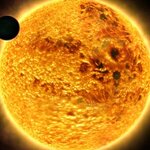
A team of astronomers have used the NASA/ESA Hubble Space Telescope to detect, for the first time, strong evidence of hazes in the atmosphere of a planet orbiting a distant star. The discovery comes after extensive observations made recently with Hubble’s Advanced Camera for Surveys (ACS).
The team, led by Frédéric Pont from the Geneva University Observatory in Switzerland, used Hubble’s ACS to make the first detection of hazes in the atmosphere of the giant planet. "One of the long-term goals of studying extrasolar planets is to measure the atmosphere of an Earth-like planet, this present…

A collaboration of over 50 astronomers, The IPHAS consortium, led from the UK, with partners in Europe, USA, Australia, has released today (10th December 2007) the first comprehensive optical digital survey of our own Milky Way. Conducted by looking at light emitted by hydrogen ions, using the Isaac Newton Telescope on La Palma, the survey contains stunning red images of nebulae and stars. The data is described in a paper submitted to the Monthly Notices of the Royal Astronomical Society.
To date, the IPHAS survey includes some 200 million unique objects in the newly released catalogue. This…
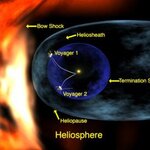
NASA's Voyager 2 spacecraft has entered a vast region at the edge of our solar system where the solar wind runs up against the thin gas between the stars, called the heliosheath, and what it found is surprising - our solar system is 'dented.'
Voyager 2 entered the heliosheath on August 30, 2007, crossing the heliosheath boundary, called the solar wind termination shock, about 10 billion miles away from Voyager 1 and almost a billion miles closer to the sun, and confirmed that our solar system is “squashed” – that the bubble carved into interstellar space by the solar wind is not perfectly…
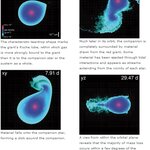
In science fiction, binary stars are often shorthand for the exotic. A pair of suns rising over some alien landscape quickly communicates the foreign and the outlandish. But that reaction just shows our bias toward what is familiar. Out in the universe, twosomes are nothing out of the ordinary. Astronomers think that a third to more than half of all stars are part of binary systems.
Northwestern University's Ronald Taam has used a progression of systems at NCSA over the last seven years to explore how these binaries operate. Taam works closely with Paul Ricker, a research scientist at NCSA…
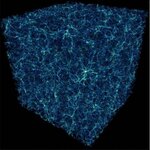
Much of the gaseous mass of the universe is bound up in a tangled web of cosmic filaments that stretch for hundreds of millions of light-years, according to a new supercomputer study by a team led by the University of Colorado at Boulder.
The study indicated a significant portion of the gas is in the filaments -- which connect galaxy clusters -- hidden from direct observation in enormous gas clouds in intergalactic space known as the Warm-Hot Intergalactic Medium, or WHIM, said CU-Boulder Professor Jack Burns of the astrophysical and planetary sciences department.
The team performed one of…